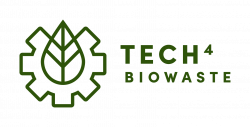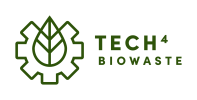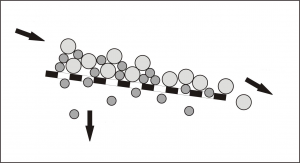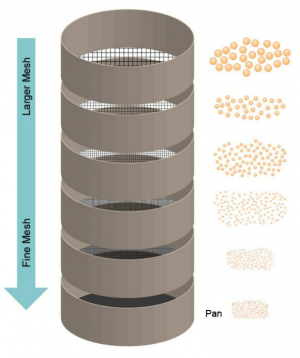Sieving
| Technology | |

| |
| Technology details | |
| Name: | Sieving |
| Category: | Pre-processing (Separation technologies), Post-processing (Separation technologies) |
| Feedstock: | all solid materials |
| Product: | separated products |
Sieving is a simple technique for classifying and separating particles of different sizes. Sieving has been around since the time of the ancient Egyptians and can be considered the backbone of particle size technology. Sieving’s continuing popularity is due to the technique’s fundamentally simple principle and methodology, historical reference, and cost effectiveness. Several instrument components involved in a sieve analysis can be quality controlled, making the technique applicable to various industries including pharmaceutical, industrial, agricultural, and chemical. In food industries sieves (often vibrating) are used to prevent the contamination of the product by foreign bodies. The main method is separation of product(s) into different fractions according to the particle size. Particles with a size bigger than the mesh of the used sieve will be withheld and smaller particles will fall through.
Feedstock
Origin and composition
The sieving method is used to separate different components from a solid mixture via separating particles of different sizes. The feedstock composition therefore is a mixture of materials of different particle size e.g. coming from a sizing pro-treatment or a drying process.
Pre-treatment
For sieving no specific pre-treatment is needed since it is used to separate different fraction within a process chain. Sometimes it is combined with other separation technologies or the particle mixtures need to be dry.
Process and technologies
While sieving may appear rudimentary compared to more modern instrumental particle sizing techniques, it still requires several important considerations to obtain the best repeatable and precise results. Several factors must be considered when developing a robust sieving method or performing a routine quality analysis. Sample size, sieving duration, controlled agitation parameters and end point determination are all critical method variables which need to be addressed.
Sieve analysis
A sieve analysis (or gradation test) is a practice to assess the particle size distribution (also called gradation) of a granular material by allowing the material to pass through a series of sieves of progressively smaller mesh size and weighing the amount of material that is stopped by each sieve as a fraction of the whole mass.
Several mechanisms are used to disperse the sample and transport it through the screens (i.e. vibration, air entrainment or flowing liquid). While considered relatively low resolution, sieving’s practical applications lend itself well to quality control specifications.
Products
Since sieving only is a method to classify particles by size there is no specific product from this technology. The process results in more homogenous material composition in the different fractions that can be used for further processing.
Post-treatment
The post-treatment of the different products are depending on the next steps within the production chain.
Technology providers
| Company name | Country | Technology subcategory | Technology name | TRL | Capacity [kg/h] | Pore size [µm] | Feedstock: Food waste | Feedstock: Garden & park waste |
|---|---|---|---|---|---|---|---|---|
| CENER (ES) | Spain | - | BIO2C – Sieving equipment | 9 | 3 | 63-200000 | ● | ● |
| FRITSCH GmbH | Germany | - | ANALYSETTE | 9 | 0.02-15 | 20-125000 | ● | ● |
| Genesis Process Solutions | United Kingdom | - | Farleygreene Sieving Technology | 9 | - | 63-16000 | ● | ● |
| RETSCH GmbH | Germany | - | RETSCH | 9 | 0.03-25 | 10-125000 | ● | ● |
| Russell Finex Limited | Belgium | - | The Finex Separator | 9 | 1360 | - | ● | ● |
| Sweco Europe S.A. | Belgium | - | ATLAS Gyratory Sifter | 9 | - | - | ● | ● |
| W.S. Tyler | USA | - | RO-TAP | 9 | - | 20-100000 | ● | ● |
CENER (ES)
| General information | |||
| Company: | CENER BIO2C | ||
| Country: | Spain | ||
| Contact: | Goizeder Barberena, info@cener.com | ||
| Webpage: | Pretreatment Unit - Cener BIO2C | ||
| Technology and process details | |||
| Technology name: | BIO2C – Sieving equipment | Technology category: | Pre-processing (Separation technologies), Post-processing (Separation technologies) |
| TRL: | 9 | Capacity: | 3 kg·h-1 |
| Pore size: | Tamices de malla de 63, 125, 250, 500, 710 micras, 1, 1.4, 2, 2.5 y 3.15 mm de luz y 200mm de diámetro. µm | Sieve material: | not relevant |
| Sieve type: | Vibratory | Surface area: | not relevant m2 |
| Other: | More info: https://www.youtube.com/watch?v=qSzeXOrNTnQ | ||
| Feedstock and product details | |||
| Feedstock: | Various Biomass Materials: Herbaceous (cereal straw, agro-residues…), woody (pine, poplar, beech, eucalyptus, pawlonia, olive tree pruning…), variety of organic wastes (including low density materials and materials with high content of fines and dust). | Product: | Separated/fractionated product according to size |
CENER Biomass Department performs applied research activities in the field of biomass, providing R&D services and technical assistance to all agents of the sector. The area is focused on the development & optimization of production processes of bioproducts, solid biofuels, advanced liquid or gaseous biofuels, as well as biorefinery concepts. Indeed, the main pillars are focused on solid biofuels, bioprocesses and comprehensive sustainability assessment. The main infrastructures in this department include the Biomass Laboratory (biomass & biofuels characterization and process development at lab scale), as well as the Biorefinery and Bioenergy Centre (BIO2C).
FRITSCH GmbH
| General information | |||
| Company: | FRITSCH GmbH | 
| |
| Country: | Germany | ||
| Contact: | Stefan Fröhlich (consultation@fritsch.de) | ||
| Webpage: | https://www.fritsch-international.com | ||
| Technology and process details | |||
| Technology name: | ANALYSETTE | Technology category: | Pre-processing (Separation technologies), Post-processing (Separation technologies) |
| TRL: | 9 | Capacity: | 0.02 - 15 kg kg·h-1 |
| Pore size: | 20-125000 µm | Sieve material: | High alloy corrosion-resistant steel |
| Sieve type: | Vibratory | Surface area: | 100 - 450 mm m2 |
| Other: | |||
| Feedstock and product details | |||
| Feedstock: | Not Disclosed | Product: | Separated/fractionated product according to size |
FRITSCH GmbH is a medium-sized family business in its fourth generation and was founded in 1920. It is globally active with subsidiaries in Russia, Singapore, China and the US. FRITSCH offers three sieve shakers, namely the ANALYSETTE 3 PRO, ANALYSETTE SPARTAN, and ANALYSETTE 18. The ANALYSETTE 3 PRO and SPARTAN have a two-dimensional sieving action and the ANALYSETTE 18 has a three-dimensional action. All three products accept dry and wet feedstocks and can be used as testing equipment in accordance with DIN EN ISO 9001.
Genesis Process Solutions
| General information | |||
| Company: | Genesis Process Solutions | 
| |
| Country: | United Kingdom | ||
| Contact: | info@genesisps.co.uk | ||
| Webpage: | https://www.genesisps.co.uk | ||
| Technology and process details | |||
| Technology name: | Farleygreene Sieving Technology | Technology category: | Pre-processing (Separation technologies), Post-processing (Separation technologies) |
| TRL: | 9 | Capacity: | kg·h-1 |
| Pore size: | 63-16000 µm | Sieve material: | Stainless steel, Magnetic, Nylon, Polyester, Phosphor Bronze, Perforated, Wedgewire |
| Sieve type: | Modular, Tipping, Vibratory | Surface area: | 0.03-1.8 m2 |
| Other: | |||
| Feedstock and product details | |||
| Feedstock: | Product: | Fractionated product according size | |
Genesis Process Solutions was established in 2007 with the aim of bringing new concepts and innovative thinking to the bulk materials handling industry. Founded by two former Brabender Technologie employees, Neil Eardley and Phil Cameron, experience of the equipment and the various industries is the key to our success. With a combined experience of over forty years in the powder handling industry, it is the ideal platform on which to base the company strategy. We strive on giving the best possible service and therefore, so much experience of the Brabender equipment is vital. Our aim is to meet customer demands for high service levels combined with the ability to provide the right solutions for an ever increasingly difficult market place.
Since we started in 2007, we have continued the good work of Brabender along with growing at a steady rate and bringing new products - such as Krause flexible silos - to the market place. We work with many blue chip companies as well as companies with one person, this way we can cover as many of the different sectors within industry as possible. Recently added to our excellent portfolio are three companies : Sinfimasa (screw conveyors), Liftvrac (tubular belt conveyor) and most recently Bay Plastics Machinery (strand pelletizers for plastics).
RETSCH GmbH
| General information | |||
| Company: | RETSCH GmbH | 
| |
| Country: | Germany | ||
| Contact: | Not Provided | ||
| Webpage: | https://www.retsch.com/ | ||
| Technology and process details | |||
| Technology name: | RETSCH | Technology category: | Pre-processing (Separation technologies), Post-processing (Separation technologies) |
| TRL: | 9 | Capacity: | 0.03 - 25 kg·h-1 |
| Pore size: | 10-125000 µm | Sieve material: | High alloy corrosion-resistant steel |
| Sieve type: | Vibratory, air jet, horizontal, tap | Surface area: | 100 - 450 mm m2 |
| Other: | |||
| Feedstock and product details | |||
| Feedstock: | Not Provided | Product: | Separated/fractionated product according to size |
RETSCH GmbH was founded in 1915 by F. Kurt Retsch. A few years later he registered his first patent in grinding technology: a mortar grinder that became famous worldwide as the RETSCH mill. Today RETSCH is the leading solution provider for size reduction and particle sizing technology with subsidiaries in the US, China, Japan, India, South Africa, France, Italy, Russia, UK, and Thailand.
RESCH offers various vibratory sieve shakers (AS200, AS300, AS450) that vary in capacity and measuring range, as well as a horizontal sieve shaker (AS 400), a tap sieve shaker (AS200 tap) and an air jet sieving machine (AS 200 jet). All instruments can be used as testing equipment in accordance with DIN EN ISO 9000 ff.
Russell Finex Limited
| General information | |||
| Company: | Russel Finex N.V. | 
| |
| Country: | Belgium | ||
| Contact: | Not Provided | ||
| Webpage: | https://www.russelfinex.com | ||
| Technology and process details | |||
| Technology name: | The Finex Separator | Technology category: | Pre-processing (Separation technologies), Post-processing (Separation technologies) |
| TRL: | 9 | Capacity: | 1360 kg·h-1 |
| Pore size: | Not Provided µm | Sieve material: | Stainless steel |
| Sieve type: | Virbatory | Surface area: | 0.76 - 1.5 m2 |
| Other: | |||
| Feedstock and product details | |||
| Feedstock: | Inputs from food & beverage, chemicals | Product: | Separated/fractionated product according to size |
Established in 1934, Russel Finex has enjoyed 85 years of successful growth to become an international group employing over 250 employees. It is globally active in the field of fine mesh separation technology, designing and manufacturing vibratory sieves, separators, ultrasonic mesh deblending systems and liquid filters for use throughout the processing industries. Russel Finex has subsidiaries in the UK, USA, Belgium, India and China.
Sweco Europe S.A.
| General information | |||
| Company: | Sweco Europe S.A. | 
| |
| Country: | Belgium | ||
| Contact: | Not Provided | ||
| Webpage: | http://sweco.com/ | ||
| Technology and process details | |||
| Technology name: | ATLAS Gyratory Sifter | Technology category: | Pre-processing (Separation technologies), Post-processing (Separation technologies) |
| TRL: | 9 | Capacity: | Not Provided kg·h-1 |
| Pore size: | Not Provided µm | Sieve material: | Stainless steel |
| Sieve type: | Horizontal | Surface area: | 3 - 49 m2 |
| Other: | |||
| Feedstock and product details | |||
| Feedstock: | Inputs from industries including chemical, food, plastics, agriculture, and minerals | Product: | Separated/fractionated product according to size |
SWECO is a business unit of M-I L.L.C. and leading manufacturer of customized industrial separation equipment. SWECO has 9 manufacturing or service facilities and over 100 sales offices worldwide. Headquartered in Florence, USA, SWECO also maintains manufacturing or service facilities in Belgium, Scotland, Italy, India, China and Singapore, a joint venture in Mexico, and a licensee in Australia.
W.S. Tyler
| General information | |||
| Company: | W.S. Tyler | 
| |
| Country: | U.S. | ||
| Contact: | Not Provided | ||
| Webpage: | https://wstyler.com/ | ||
| Technology and process details | |||
| Technology name: | RO-TAP | Technology category: | Pre-processing (Separation technologies), Post-processing (Separation technologies) |
| TRL: | 9 | Capacity: | Not Provided kg·h-1 |
| Pore size: | 20-100000 µm | Sieve material: | Stainless steel |
| Sieve type: | Tap | Surface area: | 200 or 300 mm m2 |
| Other: | |||
| Feedstock and product details | |||
| Feedstock: | Not Provided | Product: | Separated/fractionated product according to size |
W.S. Tyler is a leader in fields ranging from particle analysis, industrial woven wire, and filtration to architectural mesh. The company was founded by Washington S. Tyler in 1872 and first went by the name of Cleveland Wire Works. In 1990, The Particle Analysis & Fine Screening Division was introduced as an independent profit center of W.S. Tyler. Shortly after, this product group formed a partnership with Haver & Boecker.
There are 3 different types of mechanical sieve shakers that W.S. Tyler offers. The RX-29/30 single stack tapping machines for 8 and 12-inch sieves, the RX-812 oscillating shaker, and the RX-94, a double stack tapping machine for 8-inch sieves. There are also three different types of electromagnetic sieve shakers, namely the E pure, E Premium and E Premium Remote sieves. Only the E Premium Remote offers the possibility for wet sieving.
Open access pilot and demo facility providers
Patents
Currently no patents have been identified.
References
- Sieving in Wikipedia
- Sieve analysis

